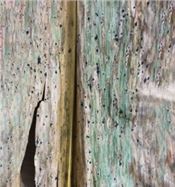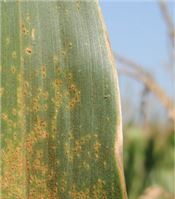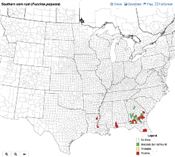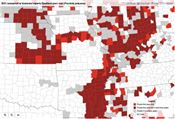Early Season Disease Report
DR. MANDY D. BISH AND MELANIE CARRAHER
COLUMBIA, MISSOURI
In mid-June, MU initiated a weekly scouting effort across regions of Missouri with focus on corn and soybean foliar diseases. Not a lot of disease to report in general. In soybean, septoria brown spot was reported in southeast Missouri. In corn, Gray Leaf Spot (GLS) has been reported in multiple regions of the state. In all but one report from northwest Missouri, severity was low with few lesions on lower canopy leaves. Dry conditions have likely contributed to the slow spread.
Areas that receive rain this weekend are likely to see an increase in severity and spread of GLS and other diseases.
Some comments and questions have come in recently about corn diseases, specifically on tar spot and southern corn rust:
Why is the TarSpotter App indicating my field is high risk?
This mobile app is a good resource to help farmers make decisions on timely applications for tar spot management. The app considers current weather conditions, corn growth stage, and management practices, including irrigation and fungicide applications, to forecast the risk of tar spot. Risks are built on the assumption that the pathogen which causes tar spot is present in the field. If tar spot has not been found in your region yet, this app is not for your field yet. Scouting is your best tool.
Will fear of tar spot dictate decision making?
Tar spot is a disease to be concerned about, but as of now, Missouri is not the hotbed for tar spot outbreak. We need to be proactive in scouting but not overreactive in application decisions.
Concerns over fungicide supply issues mean we need to ensure products are available to manage pathogens we know are present or have a high likelihood of appearing this year. You want to make sure the pathogen that causes tar spot is present and a threat before you start altering application strategies to treat for it.
If you see tar spot, do not take it lightly Based on the limited data available in the US, fungicide applications can reduce tar spot severity. Due to the recent arrival of this pathogen into the US, many questions remain about the best application timing and which chemistries have highest efficacy.
In a multi-state research trial that included Indiana, Illinois, Wisconsin, Michigan, and Ontario, Canada, applications of 13 different fungicides, made at VT or R1, each reduced disease severity at the R5 stage. When yields were compared, those applications that included multiple modes of actions corresponded to higher yields than non- treated plots or plots that received one mode of action. Again, there is still much to learn in this area.
Not sure what you are looking for?
Tar spot lesions are fairly distinct when compared to lesions caused by many other corn pathogens. Small, black, raised spots called stroma form on leaves sheaths and husks (Figure 1). The Crop Protection Network has several good images and more descriptions available on the disease.
It can be difficult to differentiate between insect frass and tar spot. Insect frass can typically be removed from the leaf with a fingernail. If you have questions or difficulty differentiating between insect frass and tar spot lesions or other abnormalities, please submit samples to Dr. Tian through the MU Plant Diagnostic Clinic.
What about southern corn rust?
This is another disease that can severely affect yield and was reported for the first times in Audrain, Bates, Bollinger, Callaway, Cooper, Dunklin, Jackson, Johnson, Stoddard, and Warren counties in 2021. In general, most hybrids are susceptible to southern rust but have some resistance to common rust. It is important to be able to distinguish between the two.
One key difference between the diseases is that southern rust pustules are typically restricted to upper leaf surfaces while common rust pustules form on both upper and lower leaf surfaces. Pustules of southern rust (Figure 3) tend to be more densely packed compared to pustules of common rust and are orange to light brown in color where as pustules of common rust are brown to brick-red. Both diseases can be present at the same time, which complicates identification. Visit the Crop Protection Network's encyclopedia on southern rust for more images and identification information. Fungicides are available for southern and common rust management.
Fungal spores for rusts diseases do not typically overwinter in Missouri. They are blown from southern states. The corn iPipe website is a good visual tool that shows where these rusts have been found so far in 2022 (Figure 4).
If you see southern corn rust or have any questions on identification or differentiation, please submit samples to Dr. Tian through the MU Plant Diagnostic Clinic. ∆
DR. MANDY D. BISH AND MELANIE CARRAHER: University of Missouri

Figure 1 Small, black raised stroma appear on tissues. Stroma cannot be scraped off the leaf surface.

Figure 3 Image of Southern rust pustules on a corn leaf Dr. Kaitlyn Bissonnette

Southern Corn Rust movement as of July 1, 2022.
Image from corn.ipmpipe.org
